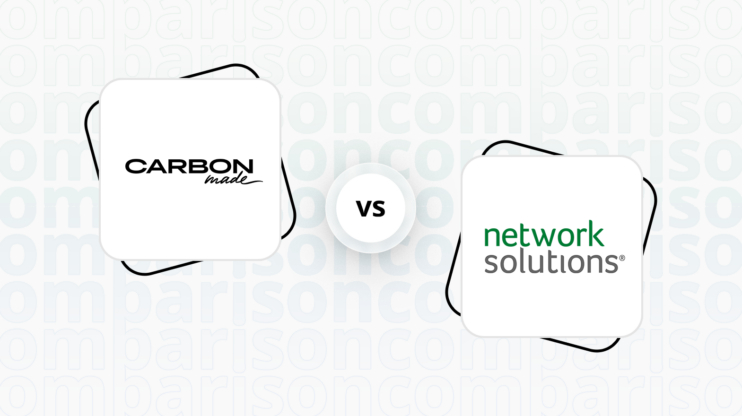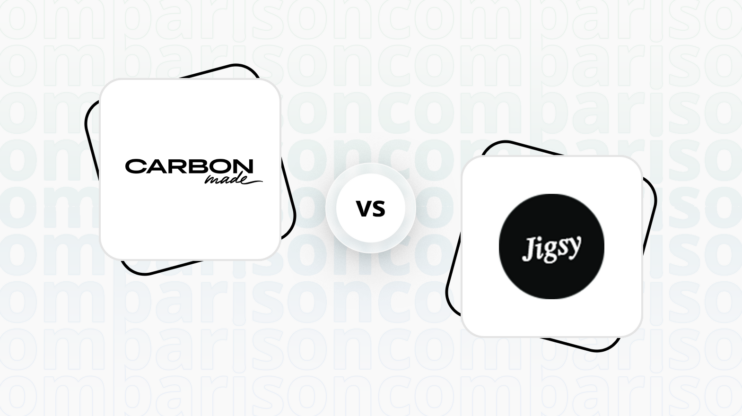Webflow vs Web.com: Final verdict
Webflow and Web.com both offer unique advantages, but they cater to different user needs and preferences.
-
Webflow (Overall Grade: 7.9/10)
is a powerful platform designed for professional designers and developers. It excels in providing extensive design functionalities, a flexible CMS, and top-tier hosting services. Webflow’s robust design tools and customization options make it ideal for users seeking creative control and advanced features. When comparing Webflow vs Web.com, Webflow stands out for its superior design capabilities, comprehensive ecommerce features, and strong customer support. -
Web.com (Overall Grade: 5.8/10)
is tailored for users without coding expertise, offering a user-friendly drag-and-drop interface and a selection of pre-built templates. It emphasizes ease of use and mobile responsiveness, making it suitable for beginners and small businesses. In the Webflow vs Web.com comparison, Web.com is a more accessible option for those looking for straightforward website creation and basic ecommerce functionalities, though it lacks the advanced features and flexibility of Webflow.

|

|
|
|---|---|---|
|
Design functionalities & templates |
8.6 |
6.4 |
|
Ease of use |
7.5 |
6.4 |
|
Ecommerce |
8.5 |
6.3 |
|
Website Editors |
9.0 |
6.6 |
|
Product testing options |
6.3 |
0.2 |
|
Price |
8.0 |
7.4 |
|
Hosting quality |
8.9 |
5.9 |
|
Website speed optimization |
8.1 |
5.8 |
|
Plugins and integrations |
5.5 |
6.7 |
|
Marketing features |
7.8 |
7.0 |
|
Customer support |
8.3 |
7.3 |
|
Security |
7.8 |
7.6 |
|
AI capabilities |
8.3 |
7.3 |
|
User Management |
8.3 |
5.2 |
Which one is the best for ecommerce: Webflow or Web.com?
 8.5
8.5
 6.3
6.3
Verdict
: Web.com is suitable for beginners and small businesses, while Webflow is better for those needing advanced customization and scalability.
-
Webflow
: Webflow is a powerful platform for creating highly customized online stores without extensive coding knowledge. It offers a range of ecommerce features, including flexible payment processing, advanced product page customization, and robust marketing tools. When comparing Webflow vs Web.com, Webflow stands out for its design flexibility and comprehensive ecommerce capabilities, making it ideal for professional designers and growing businesses. -
Web.com
: Web.com provides a user-friendly platform with essential ecommerce features aimed at simplifying the creation and management of online stores. It offers AI-driven design options and secure payment solutions, but its limited template variety and complex setup process may restrict creative freedom. Web.com is best suited for small businesses and users looking for a straightforward, cost-effective solution.
Which one is the best for informational and business websites?
 8.6
8.6
 6.5
6.5
Verdict
: When it comes to creating informational and business websites, Webflow stands out as the superior choice due to its advanced design capabilities, ease of use, and robust hosting services. Web.com, while user-friendly and suitable for beginners, falls short in comparison to Webflow’s comprehensive features and flexibility.
-
Webflow
: Webflow excels in providing a powerful design experience with a wide array of templates and customization options. Its intuitive visual interface and flexible CMS make it ideal for professional designers and businesses looking to create custom, responsive websites. With a score of 8.6, Webflow is particularly well-suited for those who need advanced design tools and top-tier hosting services. -
Web.com
: Web.com offers a straightforward platform aimed at users without coding expertise, featuring drag-and-drop functionality and a selection of pre-built templates. While it is user-friendly and includes essential features like mobile responsiveness and SEO tools, it scores 6.5, indicating it may not meet the needs of users seeking more advanced customization and design capabilities. For those comparing Webflow vs Web.com, Web.com is a decent choice for beginners but lacks the depth and flexibility that Webflow provides.
Webflow vs Web.com: Detailed comparison
Design functionalities & templates
Design FunctionalitiesRepresents how well each platform allows for creative design and customization of websites.Score Components:
- Template Variety (30%): Range and quality of design templates.
- Customization (30%): Flexibility and options for design alterations.
- User Interface (20%): Ease and intuitiveness of the design process.
- Responsiveness (10%): Adaptability to different devices and screen sizes.
- Innovation (10%): Unique design features and tools.
 8.6
8.6
 6.4
6.4
🏆
Winner: Webflow.
If you’re looking for a platform that offers more creative control and a wide array of design features, Webflow is the preferred choice.
Webflow delivers a robust design experience with a diverse range of template and customization options. Boasting over 1000 pre-built templates covering various industries and website types, including free and premium options, Webflow ensures a constantly evolving library for users. The design customization features include a visual drag-and-drop editor for real-time adjustments, fine-grained control over every aspect of the design, and the ability to inject custom code for advanced users seeking additional personalization and unique functionalities.
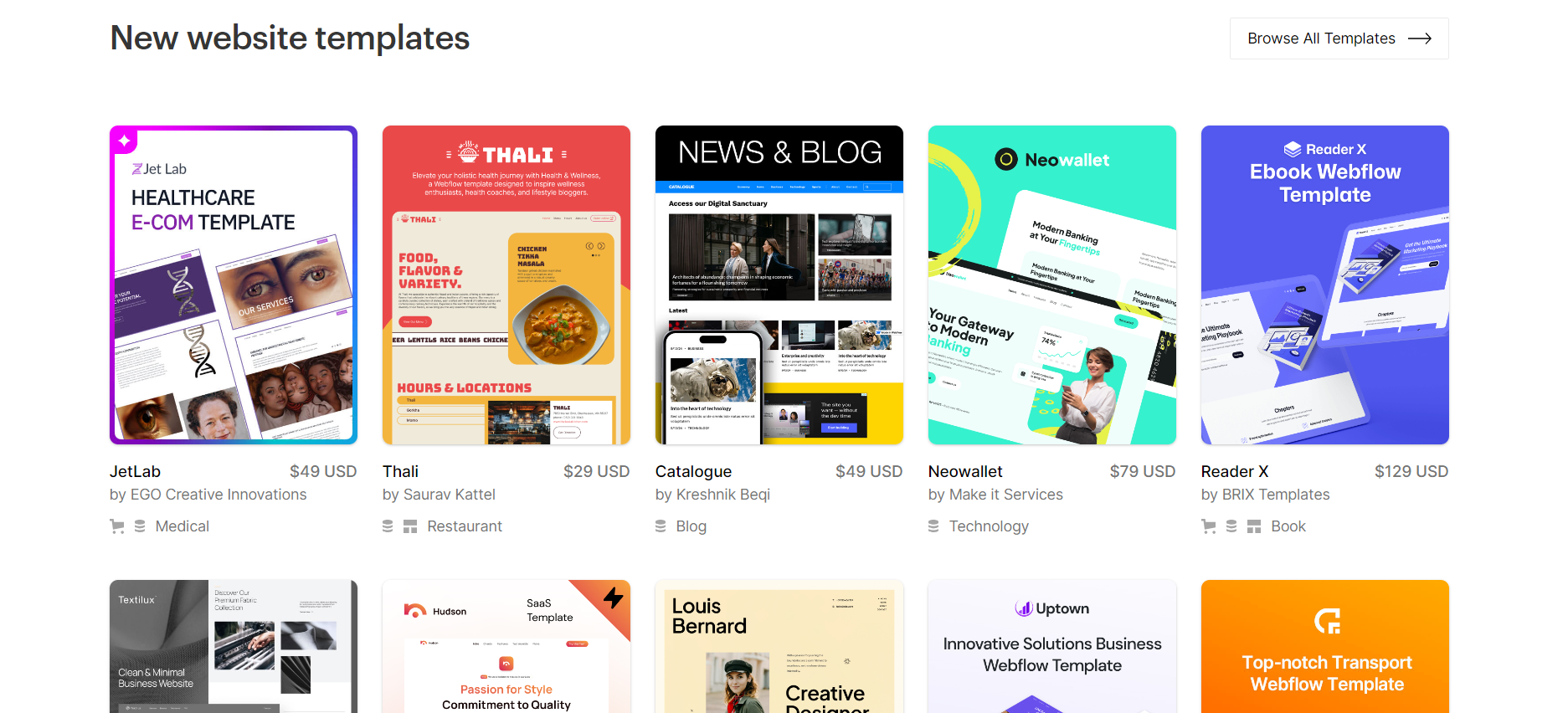
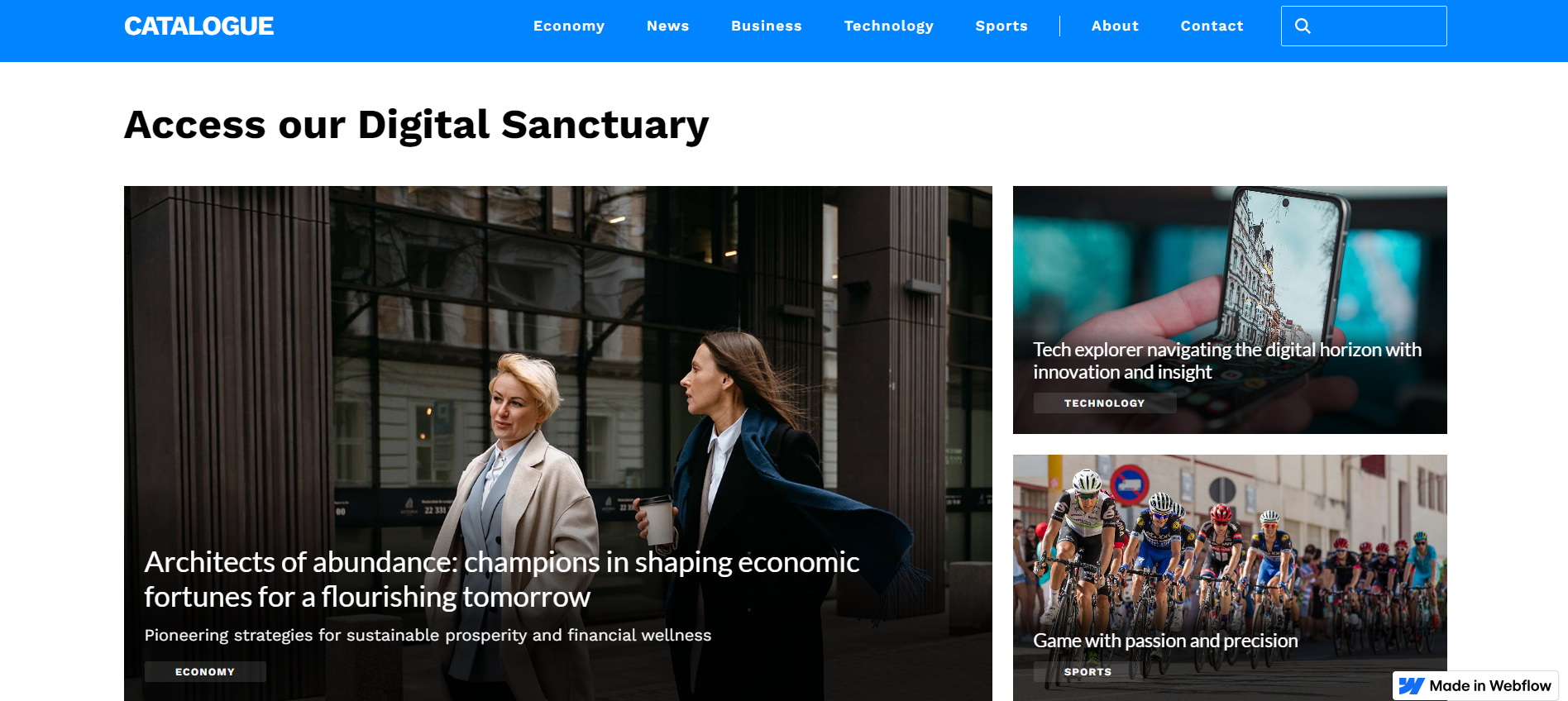
Compared to Webflow, Web.com offers over 100 website templates designed to cater to a broad spectrum of industries and personalization needs. These templates are structured to be straightforward in customization, allowing users to easily adapt their chosen designs to suit their unique brand identity through the platform’s editor. However, while the platform facilitates template customization and offers numerous pre-made layouts, it may not provide the most advanced features for all customization desires.
Get a head start on website creation with AI
Create a custom website tailored to your business needs 10X faster with 10Web AI Website Builder!
Ease of use
Ease of useReflects the platform’s overall user-friendliness.Score
Components:
- Learning curve (40%): Quickness and ease of getting started.
- Interface design (30%): Simplicity and intuitiveness of layout.
- User guidance (20%): Quality of tutorials and support.
- Flexibility (10%): Adaptability to various user skills.
 7.5
7.5
 6.4
6.4
🏆 Winner: Webflow
. Scoring 7.5, Webflow is slightly easier to use than Web.com, which scores 6.4. Webflow offers a visually intuitive interface with drag-and-drop features, making it user-friendly for experienced designers and developers. However, beginners may find it challenging due to a steeper learning curve. On the other hand, Web.com offers a wide range of templates and robust customization tools, but lacks a free plan or trial period, which could be a disadvantage for some users.
Learning Resources
🏆 Winner: Webflow
. Both platforms offer comprehensive learning resources, but Webflow goes a step further with its active community of users, providing a valuable resource for learning and support.
For ecommerce
EcommerceMeasures the platform’s effectiveness in supporting online business activities.Score Components:
- Ecommerce themes and templates (20%): Variety and design of templates.
- Product management (25%): Ease of managing and organizing products.
- Payment options (25%): Variety and convenience of payment methods.
- Ecommerce features (20%): Features for managing an ecommerce store.
- Integration (10%): Compatibility with external e-commerce tools and services.
 8.5
8.5
 6.3
6.3
Webflow and Web.com both offer ecommerce capabilities, but they cater to different needs and audiences. Webflow is a robust platform for creating online stores, offering comprehensive ecommerce features such as easy store creation without coding, extensive customization options, product management with variations, inventory tracking, integration with major payment gateways, automated shipping calculations, tax configuration, and marketing tools like abandoned cart recovery and email marketing. On the other hand, Web.com offers a suite of ecommerce features aimed at simplifying the creation and management of online stores, including AI-driven design options, customizable templates, and secure payment solutions. However, it has been noted for its complex setup process and limited template variety, which might restrict creative freedom.

|

|
|
|---|---|---|
|
Ecommerce themes and templates |
7.5 |
5.5 |
|
Product page customization |
8.3 |
6.0 |
|
Payment processing and commissions |
7.8 |
6.5 |
|
POS capabilities |
6.5 |
4.0 |
|
Payment gateways |
8.0 |
7.0 |
|
Product numbers |
7.0 |
5.0 |
|
Additional ecommerce features |
7.9 |
6.0 |
Webflow ecommerce features:
- Checkout and Payment Processing with Stripe, PayPal, etc.
- Marketing and Promotions
- Tax and Shipping calculations
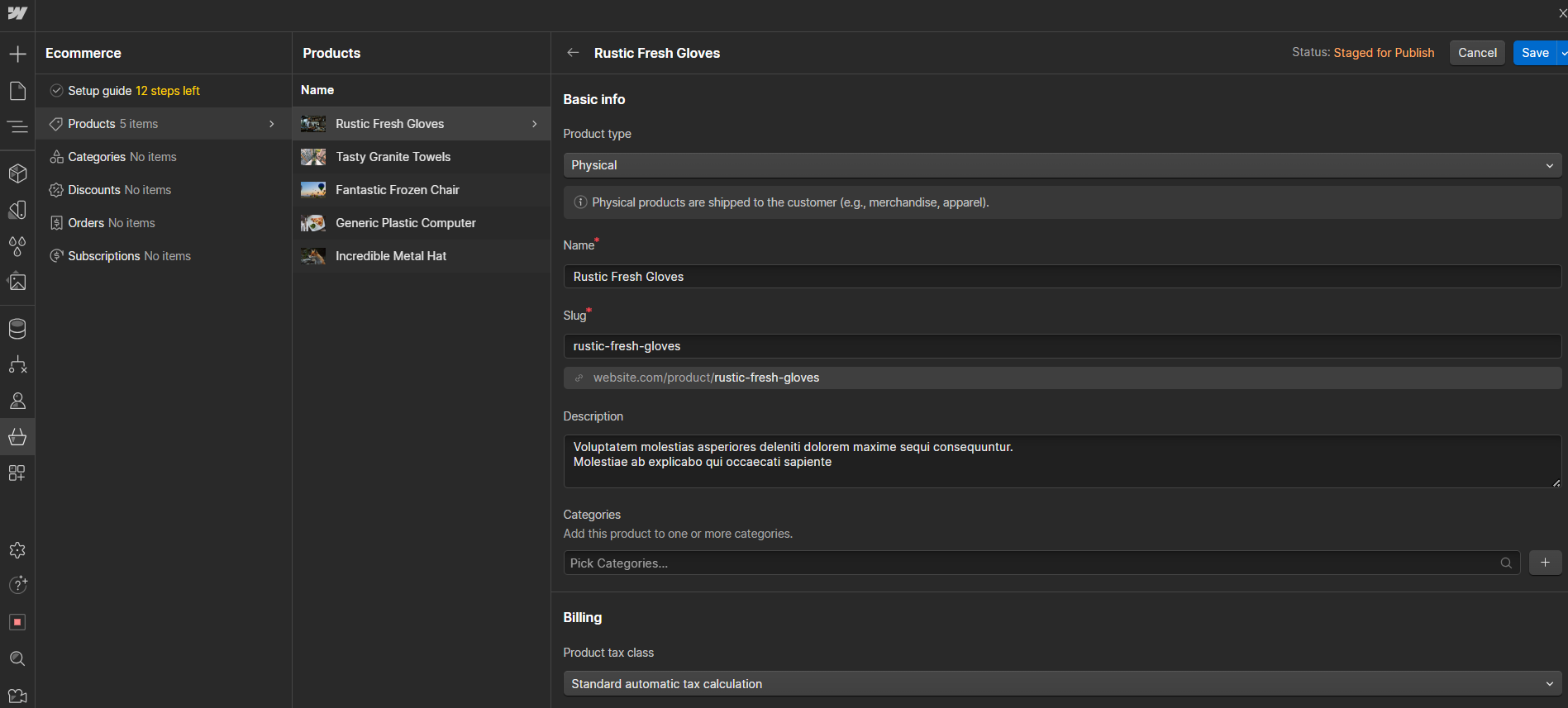
Web.com ecommerce features:
- Product listing
- Marketing Features
- Shipping options
- Payment Gateways integration
Ecommerce themes & templates
Webflow offers a diverse range of ecommerce themes and templates designed to cater to various types of online stores, from fashion and technology to artisan crafts and children’s products. Each template comes equipped with built-in ecommerce functionality, allowing you to easily add products and manage your store without the need for coding. In contrast, Web.com provides around 15 ecommerce templates designed to help businesses quickly launch and customize their online stores, emphasizing ease of use, cost-effectiveness, and professional design. These templates are compatible with Web.com’s website builder, facilitating straightforward customization and integration for digital storefronts.
Product page customization
Webflow offers extensive customization options for eCommerce product pages, allowing users to design and personalize their pages without coding. It provides tutorials for creating product pages from scratch, offers responsive templates for various devices, and allows users to add custom code and dynamic content using Webflow’s CMS for maximum customization flexibility. On the other hand, Web.com’s website builder offers a suite of tools for e-commerce stores, including product category management for organizing inventory and improving navigation, and product listing features for adding detailed product information and images. Users can create and manage product variants to accommodate items with multiple options, enhancing the customer shopping experience.
Payment processing
When it comes to payment processing, Webflow provides a flexible and secure platform for payment processing and ecommerce through integrations with leading payment gateways like Stripe and PayPal. This allows users to accept a wide range of payments, including credit card transactions directly from their websites. On the other hand, Web.com supports popular payment gateways like PayPal, Stripe, and all major debit and credit cards, ensuring a wide array of payment options for customers. However, details on transaction commissions, particularly whether Web.com imposes additional fees on transactions processed through these gateways, were not clearly stated in the reviewed sources.
Website Editors
Website EditorsEvaluates the platforms’ website building and editing capabilities.Score Components:
- Customization tools (40%): Range and power of editing features.
- Editor usability (30%): User experience within the editor.
- Design flexibility (20%): Freedom in layout and design changes.
- Update and maintenance ease (10%): Simplicity of updating and maintaining the site.
 9.0
9.0
 6.6
6.6
🏆
Winner: Webflow
. With a score of 9.0, Webflow’s editor is praised for its intuitive visual interface that simplifies the process of designing and editing responsive websites without requiring deep technical knowledge. It offers a perfect blend of ease of use for beginners and the flexibility for more advanced users, enabling significant cost savings by allowing users to customize and manage their sites without hiring professionals.
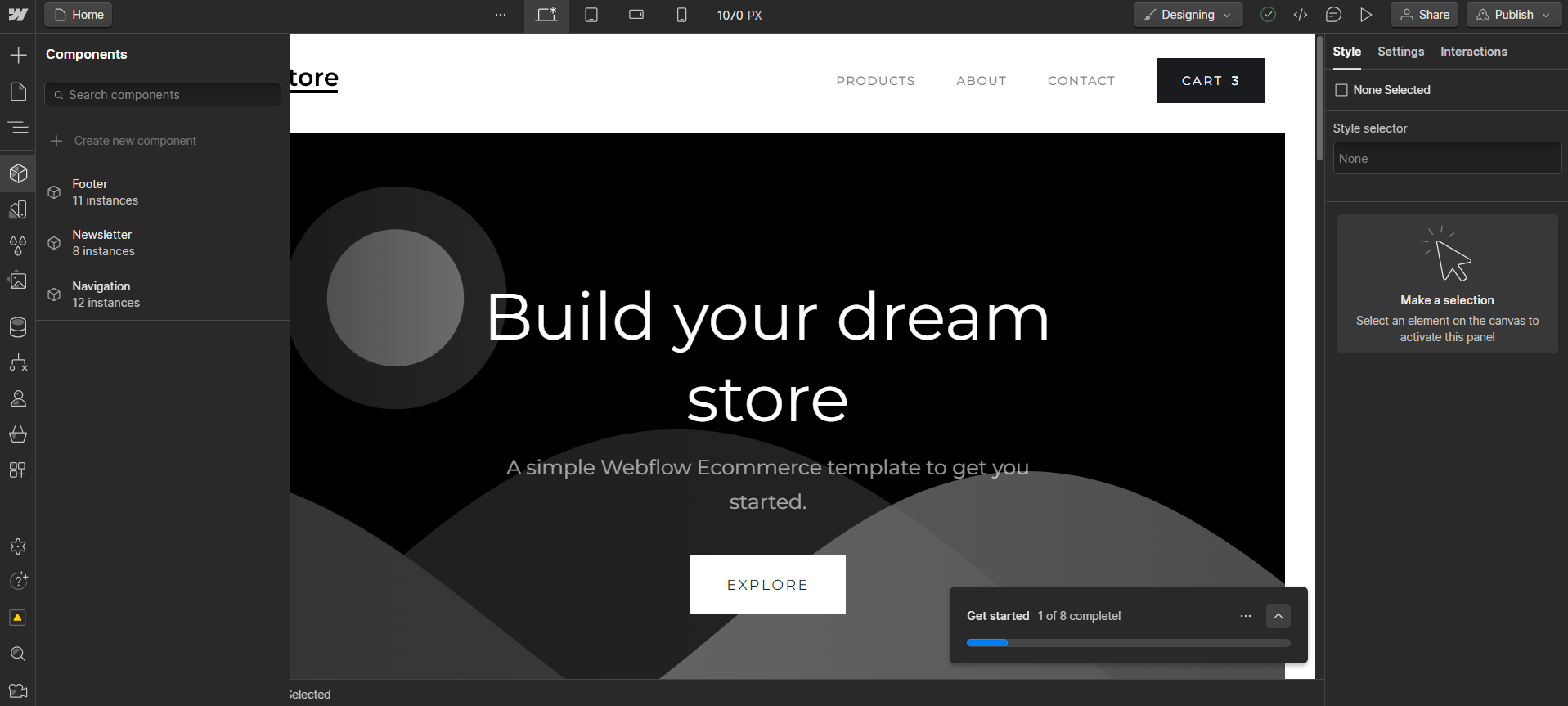
Web.com’s editor, scoring 6.6, is designed to be user-friendly, particularly suitable for beginners and those who prefer a more structured approach to website design. It offers a range of templates and a block editor that facilitates easy customization within a structured layout, albeit with some limitations in creative freedom. While the platform is accessible and competitively priced, it may not cater to all needs, especially for users seeking advanced features or extensive customization options.
Mobile editor/app
 7.0
7.0
 0
0
🏆
Winner: None
. Neither Webflow nor Web.com offer an official mobile editor app. Webflow does have a third-party app called EditFlow, created by a community member for Webflow users, but it’s only available for iOS. On the other hand, Web.com does not have a dedicated mobile editor app at all. Therefore, if mobile editing is a crucial factor for you, neither of these platforms would be the best choice.
Product testing options
Product Testing OptionsAssesses the options for trying out platform features before commitment.Score Components:
- Trial quality (40%): Extent and usefulness of the trial or free version.
- Feature accessibility (30%): How many features are available to test.
- Trial duration (20%): Length of the trial period.
- Ease of transition (10%): Smoothness of moving from trial to paid plans.
 6.3
6.3
 0.2
0.2
Overall Result
:
Webflow wins
. Webflow scores 6.3, offering a free version and the possibility to test some basic features. On the other hand, Web.com scores only 0.2, with no free or trial version and no possibility to test any features before purchasing a plan. However, Web.com does offer a 3-day money-back guarantee.

|

|
|
|---|---|---|
|
Free Plan |
Yes |
No |
|
Trial Duration |
No | No |
|
Testing Premium Features |
Some basic features with free plan |
Not possible before purchasing a plan |
|
Money Back Guarantee |
No |
3 days |
Price
PriceLooks at the cost-effectiveness and value for money of each platform.Score Components:
- Plan value (40%): What each pricing tier offers.
- Transparency and clarity (30%): Clearness of pricing structures.
- Flexibility of plans (20%): Range of options to suit different budgets.
- Hidden costs (10%): Additional expenses not included in the plan.
 8.0
8.0
 7.4
7.4
Webflow offers a wider range of pricing options, including a free plan and custom pricing for enterprise needs, while Web.com offers a simpler pricing structure with significant discounts on annual billing.

|

|
|
|---|---|---|
|
Free |
Starter (Free): Limited features for new sites, including 2 static pages and 50 form submissions lifetime. |
No offering at this amount. |
|
$10-$20 |
Basic ($18/month): Suitable for simple sites with a custom domain, including basic SEO controls and 500 monthly form submissions. And 100 pages. Value for price: 6.5 |
Website ($19.99/month): AI-powered Website Builder. Free domain & domain privacy for 1 year. Professional email for 3 months. SSL Certificate for 1 month. 1 hour expert design support. Social & email marketing tools. Value for price: 6.5 |
|
$20-$30 |
CMS ($29/month): For content-driven sites with 2,000 CMS items, 1,000 monthly form submissions, and full API access. And 150 website pages. Value for price: 7.5 |
Website + Marketing ($24.99/month): All features in the Website plan. Enhanced marketing tools. Appointment scheduling. Value for price: 7.0 |
|
$30-$45 |
Standard ($42/month): For new businesses with up to 500 ecommerce items, includes basic ecommerce features, and 2% transaction fee Value for price: 8.5 |
eCommerce ($34.99/month): All features in the Website + Marketing plan. Online store with secure checkout. Sell on multiple marketplaces like Facebook, Instagram, Amazon, eBay, etc. Value for price: 8.5 |
|
$45-$50 |
Business ($49/month): High traffic capacity, advanced features like site search, and up to 10 content editors. Value for price: 8.0 |
No offering at this amount. |
|
$80-$90 |
Plus ($84/month): Higher volume businesses with 0% transaction fees, up to 5,000 ecommerce items, and advanced features. Value for price: 9.0 |
No offering at this amount. |
|
$200+ |
Advanced ($235/month): Scalable solution for large online stores with up to 15,000 ecommerce items and the highest caps and 0% transaction fees. Value for price: 9.5 |
No offering at this amount. |
location. As a result in rare cases the prices displayed here can differ from the ones you see on their
websites.
Hosting quality
Hosting
qualityExamines the reliability and performance of the hosting solutions.Score Components:
- Uptime (40%): Consistency and reliability of website availability.
- Speed (30%): Loading times and performance.
- Bandwidth and storage (20%): Sufficiency of resources provided.
- Data centers (10%): Quality and distribution of hosting infrastructure.
 8.9
8.9
 5.9
5.9
Winner: Webflow
. Webflow offers managed hosting with a 99.99% uptime, and leverages a globally distributed network of data centers from Amazon Web Services (AWS) and Fastly. Web.com, on the other hand, offers shared hosting but does not provide uptime statistics or guarantees, and does not disclose the locations of its data centers. This makes Webflow a more reliable choice for hosting.

|

|
|
|---|---|---|
|
Do they offer hosting? |
Yes, included in all paid plans |
Yes, included in all paid plans |
|
Data Centers: |
Webflow doesn’t actually have its own data centers. Instead, it relies on a globally distributed network of data centers from Amazon Web Services (AWS) and Fastly |
Web.com does not disclose the locations of its data centers |
|
Type of hosting: |
Managed Hosting |
Shared Hosting |
|
Uptime: |
99.99% |
Web.com does not provide uptime statistics or guarantees |
|
Uptime Guarantee: |
Only Enterprise plan, 99.99% |
No |
Website Speed Optimization
Website Speed OptimizationEvaluates optimization of website loading timesScore Components:
- PageSpeed Score (30%): Google’s score indicating performance optimization.
- Loading Time (30%): The average time until a website is fully interactive.
- Mobile Optimization (15%): Optimization effectiveness for mobile devices.
- Resource Optimization (15%): Optimizing images, scripts, and other heavy resources.
- CDN Usage (10%): Use of CDN to enhance speed across geolocations.
 8.1
8.1
 5.8
5.8
🏆 Winner: Webflow
Both Webflow and Web.com have strategies in place for website speed optimization, but Webflow’s comprehensive approach and transparency about their performance metrics give them the edge.

|

|
|
|---|---|---|
|
Focus |
Custom Cache Settings, Custom Element Lazy Loading, Automatic Minification, Responsive templates, CDN |
Mobile Optimized design, Code Minification, Caching, Image Optimization |
|
Performance Tools |
Google Lighthouse, PageSpeed Insights |
Google PageSpeed Insights |
|
Key Strategies |
Custom Cache Settings, Custom Element Lazy Loading, Automatic Minification, Responsive templates, CDN |
Mobile Optimized design, Code Minification, Caching, Image Optimization |
|
Load Times |
Below 2 seconds average |
Varies depending on optimization and website complexity |
|
Page Speed Scores Range |
77.2/100 |
Varies depending on optimization and website complexity |
|
Core Web Vitals Improvement |
Improving components’ usability, and emphasis on LCP, FID and CLS |
No information provided |
Webflow’s approach to website speed optimization includes custom cache settings, custom element lazy loading, automatic minification, responsive templates, and a content delivery network (CDN). This comprehensive approach results in an average load time of below 2 seconds and a PageSpeed score of 77.2/100. Webflow also focuses on improving components’ usability and places emphasis on Largest Contentful Paint (LCP), First Input Delay (FID), and Cumulative Layout Shift (CLS) for Core Web Vitals improvements.
On the other hand, Web.com’s strategies for website speed optimization include mobile-optimized design, code minification, caching, and image optimization. However, they do not provide specific information about their load times, PageSpeed scores, or Core Web Vitals improvements. This lack of transparency makes it difficult to accurately assess their performance in website speed optimization.
Get a head start on website creation with AI
Create a custom website tailored to your business needs 10X faster with 10Web AI Website Builder!
Plugins and integrations
Plugins and integrationsMeasures the range and effectiveness of additional plugins and integrations.Score Components:
- Variety of options (40%): Range of available add-ons.
- Integration smoothness (30%): Ease of integrating plugins into the site.
- Quality of plugins (20%): Functionality and reliability of the options.
- Custom integration capabilities (10%): Support for custom or third-party integrations.
 5.5
5.5
 6.7
6.7
🏆 Winner: Web.com.
Web.com scores 6.7, offering a suite of plugins and integrations for websites built on its platform, including features for email marketing, social media engagement, analytics, and eCommerce capabilities. Webflow, with a score of 5.5, doesn’t have plugins or extensions in the traditional sense. Instead, it offers a built-in library of website elements and functionalities that you can use to create your website. This library is constantly being expanded, so you’ll always have access to the latest features and tools. However, Web.com’s more advanced functionality and greater customization and optimization opportunities give it the upper hand.
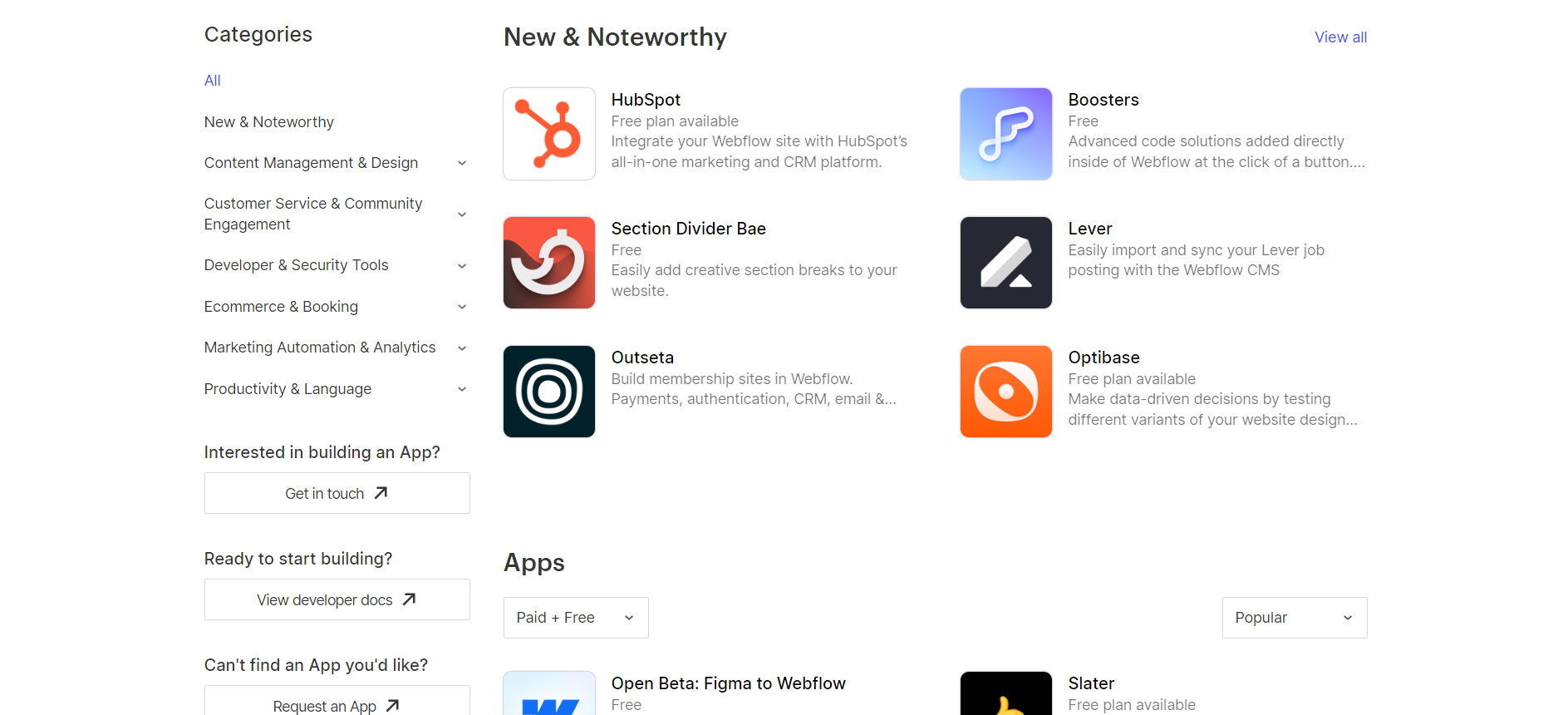
Marketing Features
Design FunctionalitiesRepresents how well each platform allows for creative design and customization of websites.Score Components:
- Template Variety (30%): Range and quality of design templates.
- Customization (30%): Flexibility and options for design alterations.
- User Interface (20%): Ease and intuitiveness of the design process.
- Responsiveness (10%): Adaptability to different devices and screen sizes.
- Innovation (10%): Unique design features and tools.
 7.8
7.8
 7.0
7.0
🏆
Overall Winner: Webflow
. Webflow stands out for its comprehensive and sophisticated marketing tools, especially in analytics and ad campaign management. Web.com, while offering a similar range of features, seems to be more basic in its offerings.

|

|
|
|---|---|---|
|
SEO Tools |
|
|
|
Email Marketing |
|
|
|
Blogging |
|
|
|
Social Media Integration |
Simplifies content sharing and audience engagement on major social platforms |
Yes |
|
Analytics and Reporting |
Integrates with Google Analytics for comprehensive web traffic and behavior analysis |
Yes, basic website analytics are included, and there’s also support for easy Google Analytics and Tag Manager setup |
|
Ads and Promotions |
Supports ad and promotion management through integration with platforms like Google Optimize |
Yes |
Customer Support
Customer supportEvaluates the quality and availability of support options.Score Components:
- Response time (40%): Speed of support responses.
- Support quality (30%): Effectiveness and helpfulness of the support.
- Availability (20%): Range of support channels (phone, chat, email).
- Resource richness (10%): Quality of self-help and educational materials.
 8.3
8.3
 7.3
7.3
🏆 Winner: Webflow
. In the Webflow vs Web.com comparison, Webflow takes the lead with a customer support score of 8.3. Webflow offers 24/7 support through live chat, email, and a community forum, ensuring users can get help whenever they need it. Additionally, Webflow provides extensive documentation and video tutorials, making it easier for users to navigate the platform and resolve issues independently.
Web.com, with a customer support score of 7.3, also provides 24/7 support through email, live chat, and phone. While Web.com offers a reliable 24/7 phone line for immediate assistance, it lacks the comprehensive documentation and community resources that Webflow provides. This makes Webflow the better option for users seeking robust and readily available support.
Security
SecurityLooks at the platforms’ security measures and data protection.Score Components:
- Data protection (40%): Safeguards for user and customer data.
- SSL and encryption (30%): Implementation of secure connections.
- Compliance (20%): Adherence to industry security standards.
- Regular updates (10%): Frequency of security updates and patches.
 7.8
7.8
 7.6
7.6
🏆
Winner: Webflow
. Webflow takes the lead in security with a score of 7.8, slightly ahead of Web.com’s 7.6. Webflow’s commitment to data privacy and security is evident in their robust encryption techniques, strict access controls, and regular system updates. They also conduct audits to identify and address potential vulnerabilities, ensuring user information remains confidential and protected.
Web.com also offers a range of services focused on private data storage and protection, including website staging environments and email solutions. Their partnership with SiteLock Security provides cloud-based security services that scan websites for malware and vulnerabilities, automatically remove malicious content, and address potential security risks. However, Webflow’s comprehensive approach to security gives it a slight edge in this comparison.
AI Capabilities
AI capabilitiesMeasures the effectiveness of AI-driven features and tools.Score Components:
- Automation efficiency (40%): Impact of AI on streamlining processes.
- Personalization (30%): AI-driven customization for users or customers.
- AI-Assisted design (20%): Role of AI in website design and functionality.
- Data analysis (10%): Use of AI in interpreting user data and analytics.
 8.3
8.3
 7.3
7.3

|

|
|
|---|---|---|
|
AI Builder |
|
AI website builder for quick and intuitive website creation |
|
AI Ecommerce Features |
|
Personalized product recommendations, automated inventory management, customer service chatbots, and data analysis tools |
|
AI Content Generation |
|
AI Writer for versatile content creation in multiple languages |
|
Additional AI Features |
Smart suggestions for design elements and layouts, AI-powered content management (announced for future releases) |
AI Domain Generator, AI Logo Builder for simplified website design and branding |
🏆 Winner: Web.com
. With a score of 7.3, Web.com offers a range of AI features that streamline the website creation process, enhance the ecommerce experience, and support content creation. Its AI website builder, AI ecommerce features, and AI Writer make it a user-friendly platform for creating and managing websites, regardless of the user’s technical skills.
Webflow, with a score of 8.3, has announced plans to introduce AI features in the future. These include an AI builder, AI content generation, and additional AI features aimed at improving the visual development learning journey and automating content updates and personalization. However, as these features are not yet available, Webflow currently lacks the AI capabilities offered by Web.com.
User Management
User ManagementAssesses the platforms’ capabilities in managing user roles, permissions, and accessibility.Score Components:
- Role Customization (40%): Flexibility in creating and defining user roles and
permissions. - Ease of Management (30%): User interface and tools for managing users.
- Access Control (20%): Effectiveness of access control measures for different user
levels. - Scalability (10%): Ability to manage a growing number of users efficiently.
 8.3
8.3
 5.2
5.2
🏆 Winner: Webflow
. Webflow and Web.com offer different approaches to user management.
- Webflow’s user management is more flexible, with the number of users who can edit a website and their access levels varying by plan. Core, Growth, and Enterprise plans offer unlimited editors, while others limit content editors to 3 or 10 per site. Access levels include Designer for full access and Editor for content editing. Workspace roles like Admin, Designer, and Editor ensure collaboration and security through features like the Site Activity Log and role-based permissions.
- Web.com allows multiple user accounts, however the platform does not specify how many accounts are supported.
Webflow User Roles and Access Levels:
| Role | Description | Access Highlights |
|---|---|---|
| Workspace Owner | Full control over Workspace settings and member management. | Edit settings, manage billing, access/edit all sites, invite/remove members, manage permissions. |
| Workspace Admin | Similar to the owner with some restrictions. | Edit settings, manage billing, access/edit all sites, invite/remove members (except owner), manage permissions. |
| Workspace Member | Limited control focused on site interaction. | Download invoices, access/edit sites, invite members. |
| Workspace Guest | Temporary collaborators with limited access. | Access/edit sites. |
| Workspace Commenter | Limited to commenting for feedback on sites. | Create/view/resolve comments, preview sites. |
| Site Admin | Full control at the site level. | Manage permissions, delete/transfer sites, billing management, design and publish changes. |
| Can Design | Design capabilities with some restrictions on publishing. | Design in Designer, create/modify classes and components, publish changes with permission. |
| Can Design (Limited) | Restricted design capabilities for Enterprise customers. | Create new classes, modify created classes, limited publishing capabilities. |
| Can Edit | Content editing without full design privileges. | Edit text/links/images, manage assets, publish Collection items and Ecommerce products. |
| Can Comment (Site Level) | Commenting for feedback at the site level. | Create/view/resolve comments, preview sites. |
Web.com User Roles and Access Levels:
| Role | Description | Access Highlights |
|---|---|---|
| Primary | The main account holder or primary user. | Edit primary user info Purchase products Manage and renew products and services |
| Admin | Users with administrative privileges besides the primary. | Edit payment information Add/Edit/Delete user roles Manage and renew products and services Edit WHOIS Admin and Tech user info |
| Tech | Users with technical responsibilities. | Manage and renew products and services Edit WHOIS Admin and Tech user info |
Additional Features

|

|
|
|---|---|---|
|
SSL Certificate |
|
|
|
Custom Domain |
|
|
|
Free Custom Domain Included |
|
|
|
International Domains |
|
|
|
Mobile Responsive |
|
|
|
Page Speed |
|
|
|
Website Builder Mobile App |
|
|
|
Convert a Website To An App |
|
|
|
Website Analytics |
|
|
|
Multilingual Sites |
|
|
|
Multiple Users |
|
|
Webflow vs Web.com: User Feedback
Webflow receives high praise for its user-friendly interface, eliminating the need for coding while offering extensive design flexibility. Users appreciate its scalability, cost-effectiveness, and seamless integration of essential features like forms and CMS. However, some users note a slight learning curve and occasional limitations, particularly in ecommerce functionalities and content management. Overall, Webflow proves to be a powerful tool for building and managing websites, offering robust features for both beginners and experienced developers, albeit with some room for improvement in certain areas like collaborative editing and content management.
Web.com, while not reviewed on G2, is designed to cater to users without coding expertise, providing drag-and-drop functionality and a selection of pre-built templates for easy website creation and customization. It emphasizes mobile responsiveness and includes eCommerce capabilities, SEO tools, and analytics features. This makes Web.com a suitable choice for both novice and seasoned users looking to establish or enhance their online presence, though specific user feedback details are not available for a direct comparison with Webflow vs Web.com.
The making of this blog
We followed a clear, step-by-step process to write and research this article.
Webflow vs Web.com: FAQ
Which platform is better for professional designers, Webflow or Web.com?
Can I use Webflow and Web.com for ecommerce?
How do Webflow and Web.com compare in terms of ease of use?
Which platform offers better hosting quality, Webflow or Web.com?
Are there any free plans available for Webflow or Web.com?
Which platform is better for website speed optimization?
How do Webflow and Web.com differ in their approach to plugins and integrations?
Which platform has better customer support, Webflow or Web.com?










